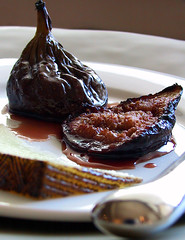The fig is a very useful plant. Its leaves have protected the modesty of Adam and Eve, as well as a host of naked mythological beings, and the fruit is among the most splendid that nature produces.
It is ironic that the leaf of the fig should be so used to avoid inflaming passion in viewers of great art, when the fruit of the tree is incredibly sensual to look at as well as eat. Further, the sap of the green parts of the fig is an irritant to human skin; a freshly plucked leaf is hardly the best choice as a covering for delicate parts.The fig is one of the first plants cultivated by humans and may even predate wheat and rye. The Romans new several cultivars and even used them to fatten geese for superior foie gras. Figs were considered so valuable and desirable in ancient Athens that there were strict laws to control harvest. The word ‘sycophant’ has its origins in ancient Greek – it literally means ‘showing the figs’ – and was used to refer to anyone who had informed on another for exporting figs (forbidden) or tattling on those who had stolen the fruit of the sacred fig trees.
Tree-ripened figs picked first thing in the morning, with the chill of the evening still on them, is one of eating’s greatest pleasures. Figs are also incredibly good for you. They’re high in calcium and fibre and are a great source of potassium. The fig has lots of antioxidants and plenty of flavonoids, which have anti-allergenic, anti-inflammatory and anti-cancer properties.
I cooked most of the figs whole but cut a couple in half to fit them into the baking dish. The halves were really good – extra tasty because the caramel syrup was drizzled directly over the interior.
Serve with a piece of very good cheddar like King Island Reserve, Spanish Manchego or French Cantal. A glass of Spanish Pedro Ximinez on the side is excellent.
The Recipe
Caramelised figs
large, very ripe purple figs
water
caster sugar
Preheat oven to 230C.
Dip the figs in water and then roll in caster sugar so that there is a generous coating all over the fig.
Place the figs standing up in a ceramic dish with sides. You can cut some of the figs in half if you like (see above) to make a neat fit in the dish.
Bake for about 20 minutes or until the sugar has dissolved on the outside and the fig looks richly brown. The syrup formed in the bottom of the dish should have taken on a caramel quality.
Remove from the oven, cool, spooning the caramel syrup over the figs as they cool. They will collapse slightly.


